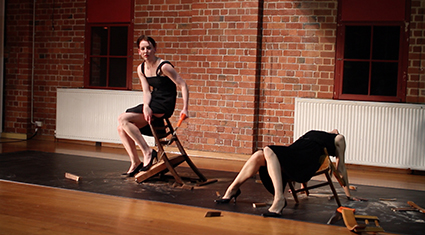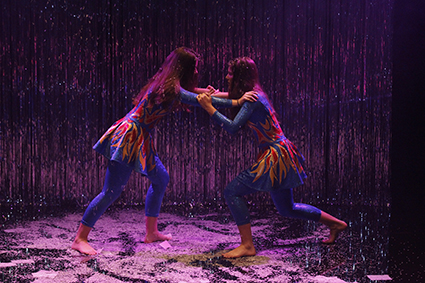 |
A String Section photo Pete Brundle |
Reckless Sleepers with Nat Cursio Co, A String Section
A String Section is a very curious work by Leen Dewilde of Belgium/UK company Reckless Sleepers and has enjoyed a number of one-off performances around the world, typically in collaboration with a local outfit. In Melbourne this came in the form of Nat Cursio Co, with both Cursio and Dewilde appearing in the production alongside other Australian dancers. It’s not quite dance per se, though the point is arguable, but it quickly becomes very apparent why physical performers are required for the piece.
The five dancers–all women—are seated on wooden chairs. Each is dressed in an elegant black dress and high heels and wears lipstick. Their attitude is one of gracious patience as the audience settles itself. In short, they look like a string section. The one thing out of place is the bows they have brought with them—generously-sized carpentry saws. The instruments they’ll be playing are the legs of the chairs themselves.
Dewilde’s concept is as simple as it is clever: from what is essentially a visual pun flowers a work whose danger I struggle to compare with much else. The women perch on their chairs in increasingly contorted poses as they hack away at the legs supporting them. When a chair leg becomes another inch shorter, the entire frame tips in a new direction, and all the while the visible threat of the saw blade is flying around among the performers’ limbs. As with a classical string section, of course, all faces remain largely expressionless besides the odd demure smile, and the blankness of affect is in stark contrast to the peril of the sharp edge dragging across a wooden limb a few hair-breadths away from a real, exposed calf.
Not much is really happening and it is entirely enthralling. The danger is somewhat heightened as legs grow shorter, seat angles more precarious and footholds (in heels!) ever less sure, but this isn’t the kind of escalating peril of circus. It’s more about the immediacy of live art, in this case observing each performer adapting their attack moment to moment as the thing supporting them disintegrates into sawdust, and attempting to maintain a particular composure almost absurd in the face of the action it accompanies, and which quickly becomes visibly tiring.
To describe this work as hypnotic isn’t enough—the state it induces is one of intense engagement with its presentness, in both a temporal and spatial sense. It is the feeling of a breath held for 50 minutes, all in the audience leaning forward, alert to every movement. It was only afterwards that I even began to consider the humorous associations behind the work—its deployment of classical music iconography—because the performance itself didn’t invite the distance required to mentally wander in those directions.
 |
I saw the second one hit photo Jeff Busby |
St Martin’s, I Saw the Second One Hit
St Martin’s I Saw the Second One Hit depends on such associations but is more surprising for it, given how its several central themes might lend themselves to more direct and mimetic exploration. It’s performed by two teenage twins who grew up in the wake of 9/11 and mines the experiences of people who have never known a world not affected by that event, but whose own understanding of it is obfuscated by adults who try to shield them from the full impact (the very fact that many young people have never heard of the World Trade Centre attacks is astonishing enough).
But director Clare Watson here takes a deeply lyrical approach to all of this. From the description I’ve provided, you wouldn’t expect the work to contain a good 10 minutes or so of callisthenics, some awkward wrestling and a lengthy discussion of the Higgs boson. There are literal references to the theatre of security that has emerged in the wake of 9/11—of the moment George W Bush was informed of the news, of water bottles confiscated at airports, of the Sydney siege and planned Anzac Day attacks—but most of the production urges audiences to find their own meaning in what is presented.
It’s worth taking up the challenge. The piece’s most rewarding sequence is in fact the long callisthenics routine, especially when glimmering metallic clubs are introduced and the girls twirl them so rapidly that they appear like the spinning cogs of some ethereal mechanism. The very martial discipline demanded of callisthenics hints at youth in military training, of individual expression filed down to a series of identical movements, but at the same time an unconscious glance from one performer towards her sister, or the slight tremble of a smile or hastily caught breath are reminders of their very humanness.
Centring the work around a pair of identical twins is a brilliant conceit. Obvious allusions to the Twin Towers aside, it allows their relationship to mirror that of Australia and the US, and to Watson’s credit she allows the many resonances here to play out subtly, largely leaving the deeper implications to the audience. Through word and gesture the twins evoke a powerful sense of both mutual dependence and a desire to each distinguish their own identity. They fight and they finish each other’s thoughts. They’re fascinated by the story of Romulus and Remus—another allusion that provokes parallels to the fall of the Towers and the twins’ own rivalries—but words are used sparingly here.
The subdued lighting, reflective flooring and sparkling tinsel backdrop do a lot to set the mesmerising tone, and the undramatic performances only add to this, but this mounting to a sustained hypnotic effect is not that of A String Section. It’s one that has the mind working at all angles, drawing lines between concepts and teasing out possible significances. The danger here is not physical but conceptual—any particular audience member just might not get it. That’s usually a risk worth taking.
Reckless Sleepers with Nat Cursio Co/Malthouse Theatre, A String Section, concept, choreography by Leen Dewilde, director Mole Wetherell, Malthouse, July 18; St Martins/Malthouse Theatre, I Saw the Second One Hit, concept, direction Clare Watson, performers Juliette Hemphil, Madeleine Hemphil, Malthouse, Melbourne, Sept 3-12
RealTime issue #129 Oct-Nov 2015 pg. 31
© John Bailey; for permission to reproduce apply to [email protected]








 back
back